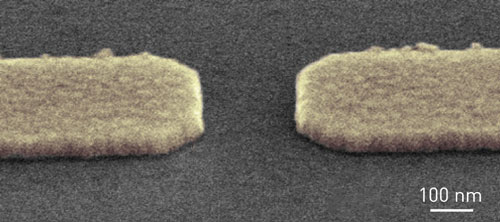| Posted: Oct 09, 2015 |
Characterizing electrons in the smallest devices
(Nanowerk News) A way to use nuclear magnetic resonance (NMR) spectroscopy to investigate electron spin in nanoscale electronic devices has been developed by RIKEN researchers.
|
|
The control of electric currents underpins all electronic devices. The most fundamental form of modifying electronic currents occurs in quantum point contacts (QPCs)—devices that have a narrow constriction between two wide electrically conducting regions (Fig. 1). Since the constriction width is comparable to the electron wavelength, quantum effects come into play and control electron movement.
|
 |
| Figure 1: The narrow constriction in a quantum point contact (defined by the two contacts on the substrate) gives rise to quantum phenomena, which can now be explored by measuring conductance and nuclear magnetic resonance signals. (Image: Minoru Kawamura, RIKEN Center for Emergent Matter Science)
|
|
One manifestation of this is that the electrical conductance of a QPC increases in regularly spaced steps as the voltage across it is increased. Additionally, an anomalous small increase in the conductance is observed at 70 per cent of the voltage at which the first step appears. The origin of this anomaly is not fully understood, but theoretical studies have suggested that it is related to electron spin.
|
|
While NMR spectroscopy can be used to investigate spin properties, it is not sensitive enough to analyze objects as small as QPCs. Now, Minoru Kawamura of the RIKEN Center for Emergent Matter Science and his colleagues at the RIKEN Center for Emergent Matter Science, Slovak Academy of Sciences and Ibaraki University have developed a way to use NMR spectroscopy to measure the magnetic properties of electrons in QPCs, enabling them to obtain a better understanding of these devices ("Electronic Magnetization of a Quantum Point Contact Measured by Nuclear Magnetic Resonance").
|
|
The researchers found that the spin of electrons in a QPC affects the way atomic nuclei respond to NMR signals, resulting in a slight shift in the NMR frequency. This frequency shift in turn measurably alters the electrical conductance of a QPC. Thus, the scientists could evaluate the properties of electronic spins by measuring the NMR signal in combination with variations in the electrical conductance. This new technique allows the magnetization of a few electron spins to be measured.
|
|
The team used this method to shed light on the nature of the additional quantum step in the conductance at 70 per cent of the regular step voltage. Their results eliminated an electronic state that had been previously proposed to promote electron conductance at this low voltage; instead, the signal appears to arise from other electronic interactions across the QPC.
|
|
The researchers are excited about the potential of method to probe other ultrasmall devices. “The present technique can open the way for studying the magnetic properties of nanoscale devices and materials such as nanowires or nanoflakes,” comments Kawamura.
|

